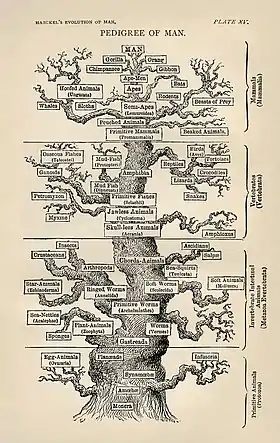Human biology
Human biology is an interdisciplinary area of study that examines humans through the influences and interplay of many diverse fields such as genetics, evolution, physiology, anatomy, epidemiology, anthropology, ecology, nutrition, population genetics, and sociocultural influences.[1] It is closely related to the biomedical sciences, biological anthropology and other biological fields tying in various aspects of human functionality. It wasn't until the 20th century when biogerontologist, Raymond Pearl, founder of the journal Human Biology, phrased the term "human biology" in a way to describe a separate subsection apart from biology.[2]Body systems Our bodies consist of a number of biological systems that carry out specific functions necessary for everyday living.
The job of the circulatory system is to move blood, nutrients, oxygen, carbon dioxide, and hormones, around the body. It consists of the heart, blood, blood vessels, arteries, and veins.
The digestive system consists of a series of connected organs that together, allow the body to break down and absorb food, and remove waste. It includes the mouth, esophagus, stomach, small intestine, large intestine, rectum, and anus. The liver and pancreas also play a role in the digestive system because they produce digestive juices.
The endocrine system consists of eight major glands that secrete hormones into the blood. These hormones, in turn, travel to different tissues and regulate various bodily functions, such as metabolism, growth, and sexual function.
The immune system is the body's defense against bacteria, viruses and other pathogens that may be harmful. It includes lymph nodes, the spleen, bone marrow, lymphocytes (including B-cells and T-cells), the thymus, and leukocytes, which are white blood cells.
The lymphatic system includes lymph nodes, lymph ducts, and lymph vessels, and also plays a role in the body's defenses. Its main job is to make and move lymph, a clear fluid that contains white blood cells, which help the body fight infection. The lymphatic system also removes excess lymph fluid from bodily tissues and returns it to the blood.
The nervous system controls both voluntary action (like conscious movement) and involuntary actions (like breathing) and sends signals to different parts of the body. The central nervous system includes the brain and spinal cord. The peripheral nervous system consists of nerves that connect every other part of the body to the central nervous system.
The body's muscular system consists of about 650 muscles that aid in movement, blood flow, and other bodily functions. There are three types of muscle: skeletal muscle which is connected to bone and helps with voluntary movement, smooth muscle which is found inside organs and helps to move substances through organs, and cardiac muscle which is found in the heart and helps pump blood.
Our bodies are supported by the skeletal system, which consists of 206 bones that are connected by tendons, ligaments, and cartilage. The skeleton not only helps us move, but it's also involved in the production of blood cells and the storage of calcium. The teeth are also part of the skeletal system, but they aren't considered bones.
The respiratory system allows us to take in vital oxygen and expel carbon dioxide in a process we call breathing. It consists mainly of the trachea, the diaphragm, and the lungs.
The urinary system helps eliminate a waste product called urea from the body, which is produced when certain foods are broken down. The whole system includes two kidneys, two ureters, the bladder, two sphincter muscles, and the urethra. Urine produced by the kidneys travels down the ureters to the bladder and exits the body through the urethra.
The skin, or integumentary system, is the body's largest organ. It protects us from the outside world, and is our first defense against bacteria, viruses, and other pathogens. Our skin also helps regulate body temperature and eliminate waste through perspiration. In addition to skin, the integumentary system includes hair and nails.
References
- Sara Stinson, Barry Bogin, Dennis O'Rourke. Human Biology: An Evolutionary and Biocultural Perspective. Publisher John Wiley & Sons, 2012. ISBN 1118108043. Page 4-5.
- "Human Biology - Definition, History and Major". Biology Dictionary. 2017-05-26. Retrieved 2019-03-22.

